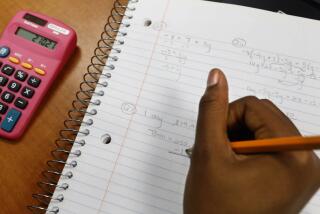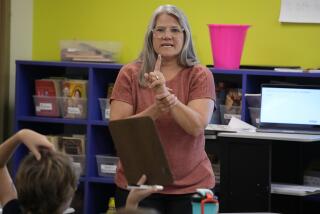Opinion: Math scares your child’s elementary school teacher — and that should frighten you
- Share via
American students remain stumped by math. The 2019 scores for the National Assessment of Educational Progress test — known as NAEP — were published last month, showing that performance for fourth- and eighth-graders hasn’t budged since 2009. That’s a year after the National Mathematics Advisory Panel, convened by President George W. Bush, concluded that American math achievement was “mediocre.”
The panel offered dozens of ideas for improvement, leading with the common-sense suggestion to strengthen the elementary math curriculum, which it deemed diffuse, shallow and repetitious in many schools. But improved curricula won’t help unless we acknowledge another significant problem: Many elementary teachers don’t understand math very well, and teaching it makes them anxious.
Consider why American kids struggle. Mathematical competence depends on three types of knowledge: having memorized a small set of math facts (like the times table), knowing standard algorithms to solve standard problems (like long division), and understanding why algorithms work (knowing why the standard method of solving long division problems yields the correct answer).
The National Mathematics Advisory Panel concluded U.S. students have adequate knowledge of the first two, but not the third. They can do math (at least, sometimes), but they often don’t understand what they are doing.
For example, a middle schooler might be able to calculate 0.77 x 0.63, but not immediately see before she calculates that the product will be less than 0.77. This shallow understanding of decimal value won’t necessarily resolve on its own. A colleague told me of vainly trying to persuade a college student that .015 was less than .05; the student insisted “but 15 is more than five.”
The equal sign is another mathematical concept that’s often misunderstood. It means, of course, that whatever is on either side of the equal sign is equivalent. But many elementary students don’t understand the meaning of the equal sign. To them, it doesn’t signify equality, but instead means “put the answer here.” Imagine their confusion when, in algebra, they first encounter problems with numbers on both sides of the equal sign.
But does that matter? If you know that to divide one fraction into another you should “flip the numerator and denominator of one, then multiply them,” is it important to be able to explain why it works?
If math knowledge is limited to “when I see this sort of problem, I do that” it’s inflexible; if problems are phrased just a little differently, the student is often stumped. And once students hit algebra, math increasingly demands thinking through a sequence of steps and picking the right mathematical tool for each. That’s hard if you don’t understand what the tools actually do.
This interpretation — that students lack conceptual understanding, and this absence of understanding matters more as math gets more difficult — fits the pattern of standardized test scores. As students advance, the percentage meeting grade-level targets on the NAEP declines. A similar trend is observed in international comparisons; American fourth-graders compete fairly well, but high-schoolers trail students from most other industrialized nations.
If high school students flounder because the groundwork of understanding was never laid in elementary grades, the National Mathematics Advisory Panel’s recommendation — change the curriculum — is on target.
What’s been overlooked is that teaching deep understanding to elementary students requires that teachers have that understanding themselves. Studies consistently show many don’t.
Research also shows that, compared with other college students, future elementary teachers are especially prone to math anxiety —apprehension about doing math that’s so severe it interferes with actually doing it. That anxiety remains once they are in classrooms, and studies show that students learn less math from a math-anxious teacher.
So perhaps we should focus on teaching the teachers, so they can teach the students. But with nearly 2 million elementary teachers in the United States, the job would be overwhelming, even if only half needed instruction.
An alternative would be to make better use of teachers who have deep math knowledge. More schools are employing math specialists, who serve as consultants to fellow teachers, and math coaches, who offer classroom observation and feedback. But these measures have not, on average, raised student achievement.
That’s understandable. A coach or specialist might persuade me to use certain methods, but if as a teacher I don’t grasp the math I won’t grasp why the methods work. Like a student who merely memorizes formulas, any teaching skill gained will be inflexible; if a situation is even a little unfamiliar, I won’t know what to do.
Rather than coaching others, the best math teachers should teach children. A corps of teachers with deep understanding of math and how to convey it could be full-time math instructors, beginning in kindergarten. It would be hard for someone with such limited contact to know the students well, and student-teacher relationships do affect student learning. Some schools find it worth it to use specialized instructors to teach music or physical education. The same should hold true for math.
The difficulty would be verifying who has deep math knowledge, since state tests that certify teachers in a specific subject have proven to be mediocre predictors of who teaches well. Additional vetting such as observing the teacher in the classroom might be needed.
Losing the responsibility to teach math might be an affront to elementary teachers, but many simply don’t understand math well enough to teach it. That’s because their teachers didn’t understand math, and it’s past time to interrupt this cycle.
Daniel T. Willingham is a professor in the department of psychology at the University of Virginia.
More to Read
A cure for the common opinion
Get thought-provoking perspectives with our weekly newsletter.
You may occasionally receive promotional content from the Los Angeles Times.










